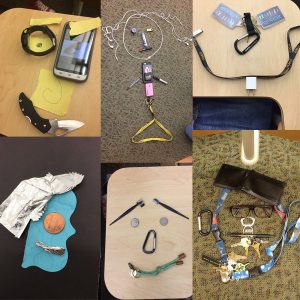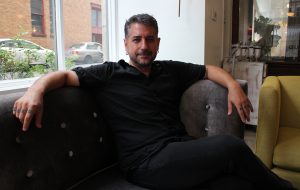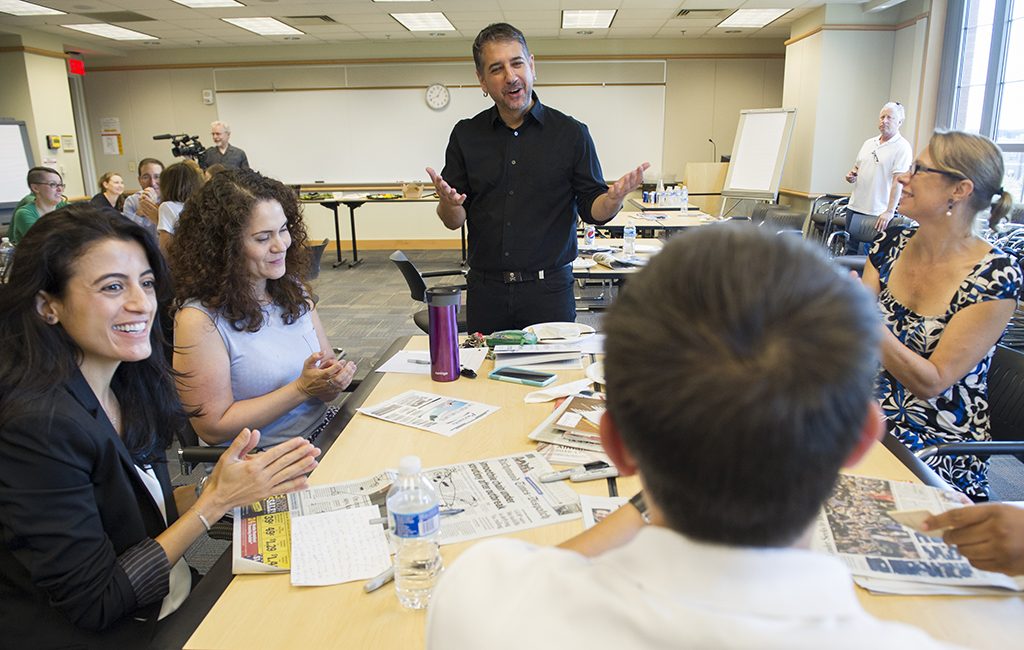A local artist who for years has worked with Fortune 500 companies on fostering innovation is bringing his approach to creativity to the VCU School of Business, which has named him its inaugural artist-in-residence.
Richmond native Noah Scalin, who gained national attention in 2007 for his yearlong Skull-A-Day project, is working with the school as part of its recently adopted strategic plan to realize its goal of incorporating creativity into its classes and curriculum.
In his new role, Scalin will conduct creative-thinking seminars with students and faculty, guest-lecture courses, create art installations to be displayed prominently in the school, and each semester lead one of the 30-day “Creative Sprint” challenges he developed through his consulting firm, Another Limited Rebellion, which has worked with such clients as Altria, Capital One, GE and Gap.

Results of Scalin’s first-day-of-school challenge for students to create smiley faces with items in their backpacks. (Courtesy Noah Scalin)
VCU senior associate dean Ken Kahn came up with the artist-in-residence program and reached out to Scalin after hearing him speak at this year’s VCU Innovation Summit.
“We want to do something different so students realize we are serious about business and creativity,” Kahn said. “I mean, how many business schools have an artist doing an installation in their school of business?”
Setting the tone for achieving that goal, Scalin kicked off the schoolyear by welcoming incoming freshmen and students on the first day with an unexpected challenge: create smiley faces using items in their backpacks.
Scalin sat down with BizSense to discuss his approach to encouraging creativity in business, his own experiences running a business, and his goals for the artist-in-residency program. Below is an edited transcript:
Richmond BizSense: Describe what you do with your consulting firm and what you convey to the businesses you work with.
Noah Scalin: What we’re doing really is teaching a set of tools that artists have always learned and always known and has never been taught to businesspeople, and are fairly essential. Every business we talk to says: “What we most desperately need right now is innovation. That’s the only thing that’s going to help us survive in this endlessly volatile market. The old way doesn’t work; old businesses aren’t surviving; new things are coming in constantly. How do we do this?” “Innovation” is the buzzword. But what does that mean?
What it really is: you’re saying we need everyone that works for us to be thinking creatively, be creative problem-solvers. You know who’s the best at that? Artists. Artists spend all their time doing creative problem-solving, creating incredible things that never existed before. It’s what they’re taught how to do: how to see the world as full of opportunity; how to make things out of nothing, with nothing. No money, no time, and make amazing things. So really my job is to come in and teach what it is that artists know to businesses and help people recognize that they are creative.
 RBS: You received widespread attention for your Skull-A-Day project, which led to book deals and talks and helped develop your consulting work. What was that about?
RBS: You received widespread attention for your Skull-A-Day project, which led to book deals and talks and helped develop your consulting work. What was that about?
NS: I hit a creative slump in 2007, so what I did was, literally every day for a year, I woke up and thought of some way of making a skull – and it could be with any technique, any material, stylized, realistic, but the trick was it had to be done in that day and it had to be posted online and shared. It took less than two weeks for it to go viral, and I ended up with this really huge audience that then was checking in on me every day.
RBS: How did that experience shape what you’re doing now?
NS: This idea of creative practice that I learned from my Skull-A-Day Project really got synthesized into a set of principles, a set of tools. They’re nothing that I’ve invented, but I think I’m able to come in with such an unusual story and such an engaging set of experiences that people finally, in many cases, are hearing something that they’ve maybe heard a dozen times and they finally understand it or embrace it – this idea that creativity is not a talent; it’s a practice, and anybody can practice it.
Artists have to experiment and have to spill things and have to make mistakes to create new technique. They let randomness drive their creation. It’s not to say that business should be run that way, but you have to make room for creativity. And if you don’t have room for it, you will never have innovation. I think that’s the problem: too many businesses are like, “We have no time for this, but we do want the results.”
RBS: What is your hope for the artist-in-residence program?
NS: I really want to help them change the way the students are being taught, because it’s actually a thing they want to do. The school said in their new vision statement that creativity is a priority and so important in business. That’s amazing. I agree. But how does that actually play out day-to-day? They’re trying to figure it out.
What’s great is I’m here able to help them figure it out, and also to show that this is true: I talk to businesses, Fortune 500 businesses across the country – they are asking for this. You’ve got successful, type-A businesspeople in my sessions who are struggling, because their bosses are saying: “You can’t do things the way you did before. We need innovation. You’ve got to do something different. It doesn’t work. What have you got?” They’ve got nothing, because they’ve only worked linearly before, and now they’re at a loss.
A local artist who for years has worked with Fortune 500 companies on fostering innovation is bringing his approach to creativity to the VCU School of Business, which has named him its inaugural artist-in-residence.
Richmond native Noah Scalin, who gained national attention in 2007 for his yearlong Skull-A-Day project, is working with the school as part of its recently adopted strategic plan to realize its goal of incorporating creativity into its classes and curriculum.
In his new role, Scalin will conduct creative-thinking seminars with students and faculty, guest-lecture courses, create art installations to be displayed prominently in the school, and each semester lead one of the 30-day “Creative Sprint” challenges he developed through his consulting firm, Another Limited Rebellion, which has worked with such clients as Altria, Capital One, GE and Gap.

Results of Scalin’s first-day-of-school challenge for students to create smiley faces with items in their backpacks. (Courtesy Noah Scalin)
VCU senior associate dean Ken Kahn came up with the artist-in-residence program and reached out to Scalin after hearing him speak at this year’s VCU Innovation Summit.
“We want to do something different so students realize we are serious about business and creativity,” Kahn said. “I mean, how many business schools have an artist doing an installation in their school of business?”
Setting the tone for achieving that goal, Scalin kicked off the schoolyear by welcoming incoming freshmen and students on the first day with an unexpected challenge: create smiley faces using items in their backpacks.
Scalin sat down with BizSense to discuss his approach to encouraging creativity in business, his own experiences running a business, and his goals for the artist-in-residency program. Below is an edited transcript:
Richmond BizSense: Describe what you do with your consulting firm and what you convey to the businesses you work with.
Noah Scalin: What we’re doing really is teaching a set of tools that artists have always learned and always known and has never been taught to businesspeople, and are fairly essential. Every business we talk to says: “What we most desperately need right now is innovation. That’s the only thing that’s going to help us survive in this endlessly volatile market. The old way doesn’t work; old businesses aren’t surviving; new things are coming in constantly. How do we do this?” “Innovation” is the buzzword. But what does that mean?
What it really is: you’re saying we need everyone that works for us to be thinking creatively, be creative problem-solvers. You know who’s the best at that? Artists. Artists spend all their time doing creative problem-solving, creating incredible things that never existed before. It’s what they’re taught how to do: how to see the world as full of opportunity; how to make things out of nothing, with nothing. No money, no time, and make amazing things. So really my job is to come in and teach what it is that artists know to businesses and help people recognize that they are creative.
 RBS: You received widespread attention for your Skull-A-Day project, which led to book deals and talks and helped develop your consulting work. What was that about?
RBS: You received widespread attention for your Skull-A-Day project, which led to book deals and talks and helped develop your consulting work. What was that about?
NS: I hit a creative slump in 2007, so what I did was, literally every day for a year, I woke up and thought of some way of making a skull – and it could be with any technique, any material, stylized, realistic, but the trick was it had to be done in that day and it had to be posted online and shared. It took less than two weeks for it to go viral, and I ended up with this really huge audience that then was checking in on me every day.
RBS: How did that experience shape what you’re doing now?
NS: This idea of creative practice that I learned from my Skull-A-Day Project really got synthesized into a set of principles, a set of tools. They’re nothing that I’ve invented, but I think I’m able to come in with such an unusual story and such an engaging set of experiences that people finally, in many cases, are hearing something that they’ve maybe heard a dozen times and they finally understand it or embrace it – this idea that creativity is not a talent; it’s a practice, and anybody can practice it.
Artists have to experiment and have to spill things and have to make mistakes to create new technique. They let randomness drive their creation. It’s not to say that business should be run that way, but you have to make room for creativity. And if you don’t have room for it, you will never have innovation. I think that’s the problem: too many businesses are like, “We have no time for this, but we do want the results.”
RBS: What is your hope for the artist-in-residence program?
NS: I really want to help them change the way the students are being taught, because it’s actually a thing they want to do. The school said in their new vision statement that creativity is a priority and so important in business. That’s amazing. I agree. But how does that actually play out day-to-day? They’re trying to figure it out.
What’s great is I’m here able to help them figure it out, and also to show that this is true: I talk to businesses, Fortune 500 businesses across the country – they are asking for this. You’ve got successful, type-A businesspeople in my sessions who are struggling, because their bosses are saying: “You can’t do things the way you did before. We need innovation. You’ve got to do something different. It doesn’t work. What have you got?” They’ve got nothing, because they’ve only worked linearly before, and now they’re at a loss.



